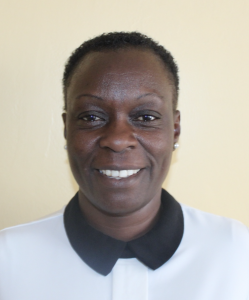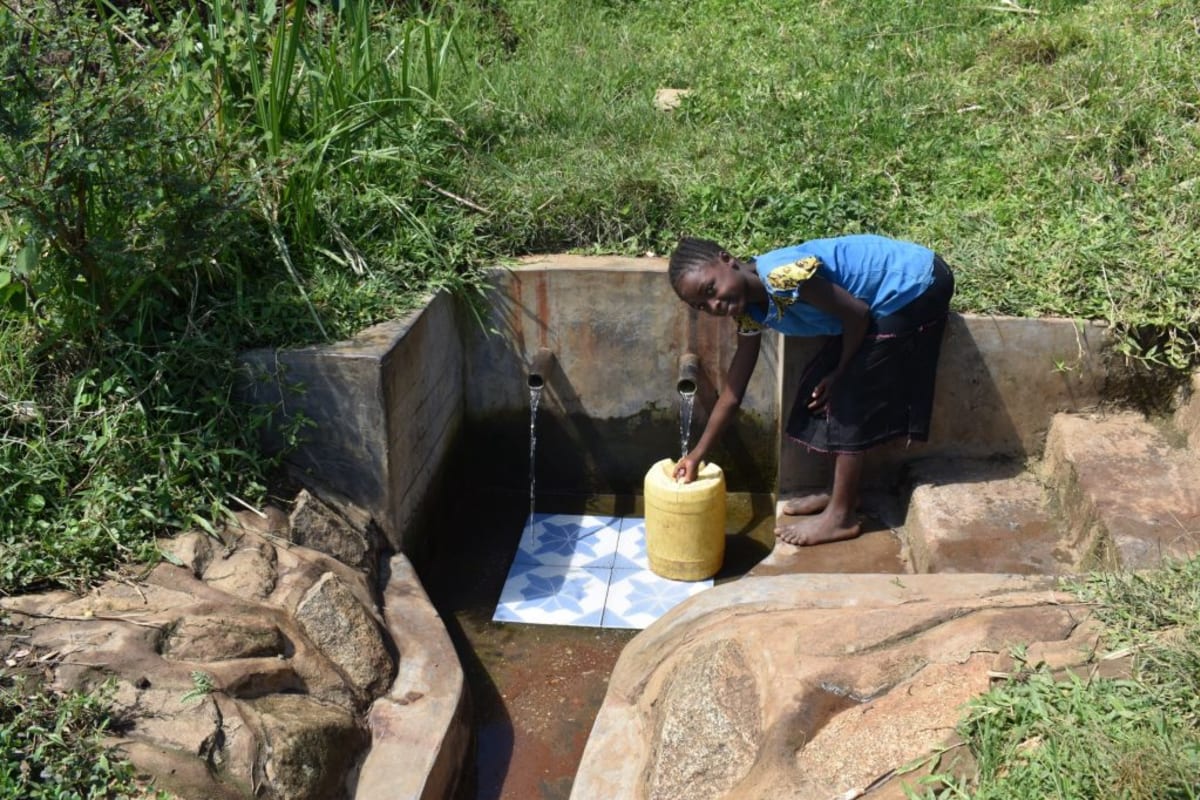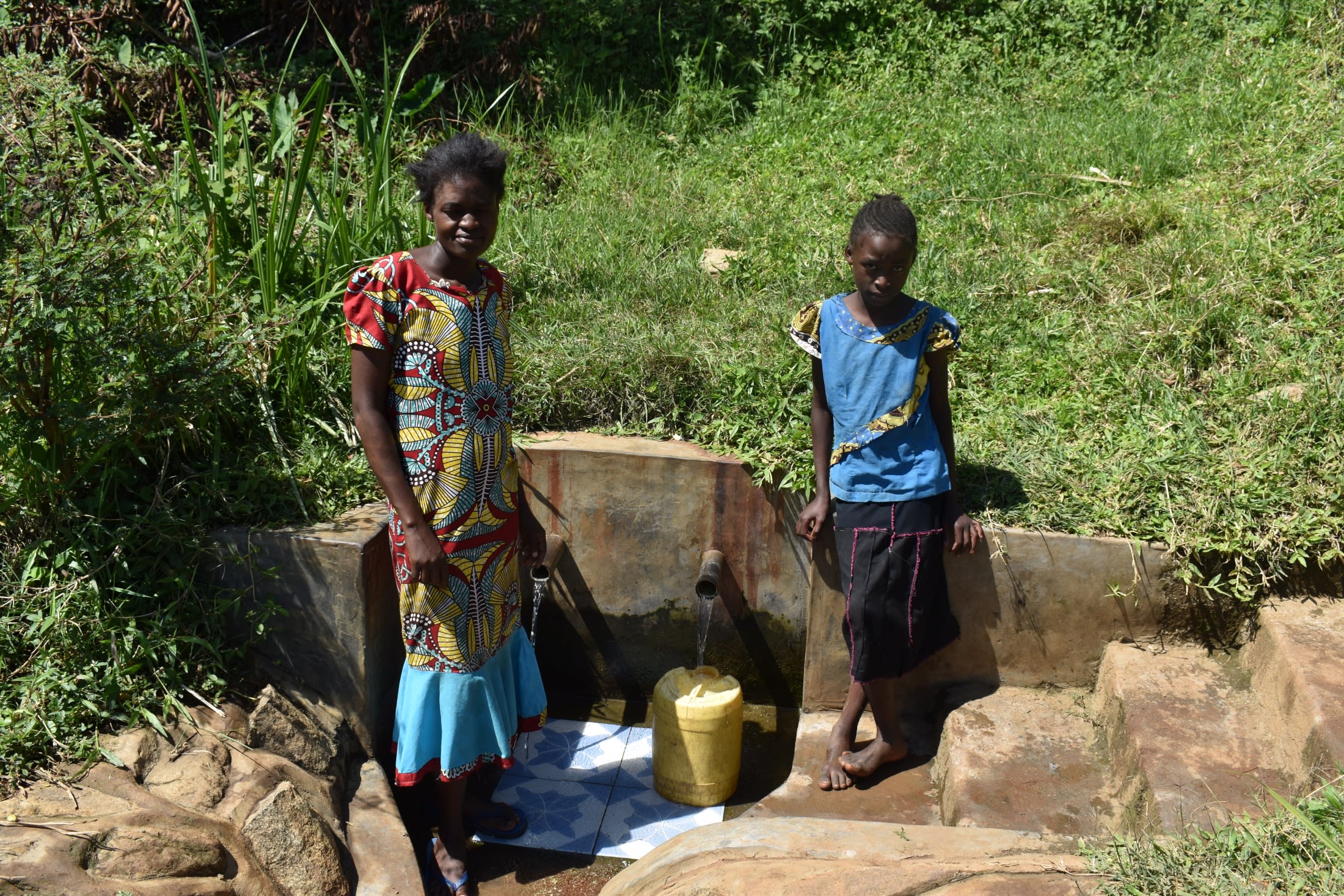July, 2020: COVID-19 Prevention Training Update at Mahira Community, Jarius Mwera Spring
Our teams are working on the frontlines of the COVID-19 pandemic. Join us in our fight against the virus while maintaining access to clean, reliable water.

We are carrying out awareness and prevention trainings on the virus in every community we serve. Very often, our teams are the first (and only) to bring news and information of the virus to rural communities like Mahira, Kenya.
We trained more than 14 people on the symptoms, transmission routes, and prevention of COVID-19. Due to public gathering concerns, we worked with trusted community leaders to gather a select group of community members who would then relay the information learned to the rest of their family and friends.
We covered essential hygiene lessons:
- Demonstrations on how to build a simple handwashing station
- Proper handwashing technique
- The importance of using soap and clean water for handwashing
- Cleaning and disinfecting commonly touched surfaces including at the water point.

We covered COVID-19-specific guidance in line with national and international standards:
- Information on the symptoms and transmission routes of COVID-19
- What social distancing is and how to practice it
- How to cough into an elbow
- Alternative ways to greet people without handshakes, fist bumps, etc.
- How to make and properly wear a facemask.
During training, we installed a new handwashing station with soap near the community’s water point, along with a sign with reminders of what we covered.
Due to the rampant spread of misinformation about COVID-19, we also dedicated time to a question and answer session to help debunk rumors about the disease and provide extra information where needed.
We continue to stay in touch with this community as the pandemic progresses. We want to ensure their water point remains functional and their community stays informed about the virus.
Water access, sanitation, and hygiene are at the crux of disease prevention. You can directly support our work on the frontlines of COVID-19 prevention in all of the communities we serve while maintaining their access to safe, clean, and reliable water.

June, 2020: Mahira Community, Jairus Mwera Spring Project Complete!
Please note, all photos in this report were taken before social distancing recommendations went into effect.
Mahira Community now has access to clean water! Jairus Mwera Spring has been transformed into a flowing source of water thanks to your donation. We protected the spring, constructed 5 sanitation platforms for different households in the community, and we trained the community on improved sanitation and hygiene practices.

"I am grateful for the protection of the spring. Apart from accessing clean and safe drinking water, I will now have sufficient time to engage in other economic activities, both on-farm and off-farm. Instances of waterborne diseases will reduce; hence there will be a reduction in the expenses on medical care. I will have access to clean and safe drinking water, and I will have more time for other domestic activities," said Absolom Mwera.

Mr. Mwera happy at the spring's completion
Children were just as excited about the completed project.
"Access to clean and safe drinking water will save me the time I would have spent going to fetch water from the unprotected spring," said teenage student Lavin.

"I believe I will now have sufficient time to concentrate on my studies. I see my academic performance improving, and my concentration in academic work will be enhanced. Less time will be spent at the protected spring. In addition, clean water will be available always."

Preparing for Spring Protection
Before national recommendations went into place for social distancing and staying at home, community members worked together to source and carry all locally available construction materials to the spring. These included bricks, sand, stones, and fencing poles. Some people also chiseled away at large stones to break them down into gravel. Because people have to carry most items by hand, the materials collection process can take anywhere from a few weeks to months.

A community member breaks stones into gravel
When everything was prepared, we sent a lorry to the community to deliver the rest of the construction materials including the cement, plastic tarps, and hardware. Then, our artisan and field officers deployed to the spring to begin work. While the field officers traveled to and from the site each day throughout the construction process, the artisan remained in the community. To accommodate him, individual households provided meals and a place to sleep each night.

Kids help carry bricks to the construction site
The last step before construction commenced was taking a water sample from the unprotected spring. We sent the sample to a government laboratory for testing to identify the kinds of contaminants in the water before its protection. These often include fertilizers and pesticides from farms, animal and human feces, and any number of harmful bacteria. We then shared the test results with the community to identify extra steps they could take to help ensure the spring’s water remains clean and safe after protection.
From Open Source to Protected Spring: A Step-by-Step Process
At last, it was time to dig in at the spring!
Women and men lent their strength to the artisan each day to help with the manual labor. First, we cleared and excavated the spring area. We dug a drainage channel below the spring and several surface runoff diversion channels above and around the spring. These help to divert the environmental contaminants identified in the pre-construction water quality test.

Excavation begins with help from the community
To ensure community members could still fetch water throughout the construction process, we also dug temporary diversion channels from the spring’s eye around the construction site. This allowed water to flow without severely disrupting community members’ water needs or construction work.
Excavation created space for setting the spring’s foundation made of thick plastic tarp, wire mesh, concrete, and waterproof cement. After setting the base, we started brickwork to build the headwall, wing walls, and the stairs.

Brickwork begins on the concrete base
Next, we began one of the most crucial steps of spring protection to ensure a fully functional water point: setting the discharge pipe, or 2 in this case, due to the spring's naturally high yield. The discharge pipes have to be set low enough in place in the headwall so that the water level inside never rises above the spring’s eye, yet high enough to leave 18-20 inches between the pipes and the spring floor to allow room for the average jerrycan (a 20-liter container) to sit beneath the pipes without making contact.

Setting the discharge pipes
If the discharge pipes were placed too high above the spring’s eye, too much backpressure could force the flow to emerge elsewhere. Too low, and community members would not be able to easily access the water. We embedded the pipes using clay (or mortar when the clay is in short supply) and placed them at a slight incline to ensure water flows in the right direction.

Cementing the stone pitching
In coordination with brickwork, we pitched medium to large stones on both sides of the spring’s drainage channel. We then cemented and plastered each stone group into place, forming the rub walls. These help to discourage people and animals from trying to stand on that area, which could cause soil erosion and thus a clogged drainage area.

Cementing the stairs
With brickwork and stone pitching completed, we turned to cement and plaster both sides of the headwall and wing walls. This reinforces the brickwork and prevents water in the reservoir from seeping through the walls. In turn, this builds enough pressure in the reservoir box to push water out through the discharge pipe.

Setting the tiles
As the headwall and wing walls were curing, we cemented and plastered the stairs and installed 4 tiles beneath the discharge pipes. The tiles protect the concrete from the erosive force of the falling water, beautify the spring, and facilitate easy cleaning of the spring floor.

Backfilling with stones
With the tiles in place, we transitioned to the final stages of construction - backfilling the reservoir box. First, we cleared the collection box of any debris that may have fallen in since its construction such as dead leaves or other items. Then we redirected the temporary diversion channels back into the reservoir box, channeling water into this area for the first time. We closed off all of the other exits to start forcing the water through the discharge pipe only.

Backfilling with soil and tarp over the stones
With much help from the community, we filled up the reservoir area with the clean and large stones they gathered, arranging them in layers like a well-fitting puzzle. We covered the stones with a thick plastic tarp to minimize potential sources of contamination from aboveground, followed by a layer of soil. We piled enough soil on top to create a slight mound to compensate for the backfill’s future settlement.

Women plant grass over the backfilled area
Community members transplanted grass onto the backfilled soil to help prevent erosion. Finally, the collection area was fenced in to discourage any person or animal from walking on it since compaction can lead to disturbances in the backfill layers and potentially compromise water quality.

Securing the fencing around the spring
The entire construction process took about 2 weeks of work and patience to allow the cement and plaster to finish curing. As soon as it was ready, people got the okay from our field officers to begin fetching water. We met them there to celebrate this momentous occasion. Happiness, thanksgiving, and appreciation were the order of the day flowing in all directions.

Community members celebrate the spring
The community members were extremely happy about the completion of the protection work at the spring. They broke into song and dance at the end of the last day of work. They confessed that many people had more often than not promised to protect the spring, but they had never honored their promise. Our team, however, had done them good, they said.

Obama smiles while playing in the spring water
Sanitation Platforms
All 5 sanitation platforms have been completed and handed over to their new owners. These 5 families are happy about this milestone of having a private latrine of their own and are optimistic that people will no longer leave waste outdoors. We are continuing to encourage families to finish building walls and roofs over their new latrine floors, and for other families to replicate the design after having helped construct these examples.

Posing on top of a completed sanitation platform, or "sanplat"
New Knowledge
Community member and spring landowner Mr. Mwera helped organize the training in coordination with our team. Together we found the community’s preferred date for training while considering other events in the community calendar such as the agricultural season and expected gatherings. When the day arrived, Facilitators Samuel Simidi and Mary Afandi deployed to the site.

Trainer Mary Afandi leading a session
30 people attended training, including the local health volunteer Rhoda Joel. Training was held at spring landowner Mr. Kevin Mwera's homestead. The attendance was wonderful as more people came than were expected, which was good.

Dental hygiene session with Trainer Samuel Simidi (right)
We covered several topics including community participation in the project; leadership and governance; personal and environmental hygiene; water handling and treatment; operation and maintenance of the spring and sanitation platforms; dental hygiene; the 10 steps of handwashing, and how to make and use a tippy tap and leaky tin. During the leadership and governance session, we held an election for the leaders of the newly formed water user committee.

Participants take notes at training
We also brainstormed income-generating activities that can be used to start both a community savings account for any future minor repairs to the spring, as well as a cooperative lending group to enable members to develop their own small businesses.
At the time, there were just 7 COVID-19 cases in Kenya, so this was a training topic we were sure to cover. This ended up being the most memorable topic since the virus was still new to Kenya. We covered key hygiene and virus-specific prevention measures, including handwashing with soap, avoiding crowded places, avoiding coming into physical contact with others, and observing social distancing.
We have since developed trainings entirely focused on COVID-19 sensitization and prevention. Join our teams on the frontline in the fight against this virus.

Learning the 10 steps of handwashing
Social distancing in particular was a new concept at the time and one that strongly goes against cultural norms. While participants were hesitant to try it out during training, we emphasized its importance and effectiveness in combating the virus.
"The knowledge gained will help me observe personal hygiene and adhere to the sanitation requirements. The mistakes that I have been doing - I will never repeat them," said Community Health Volunteer Rhoda Joel.

Handwashing practical
When an issue arises concerning the water project, the water user committee is equipped with the necessary skills to rectify the problem and ensure the water point works appropriately. However, if the issue is beyond their capabilities, they can contact our team of field officers to assist them. In addition, we will continue to offer them unmatchable support as a part of our ongoing monitoring and maintenance program.
Thank you for making all of this possible!


 Protected Spring
Protected Spring
 Rehabilitation Project
Rehabilitation Project


















































